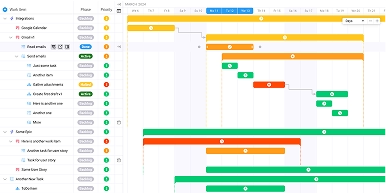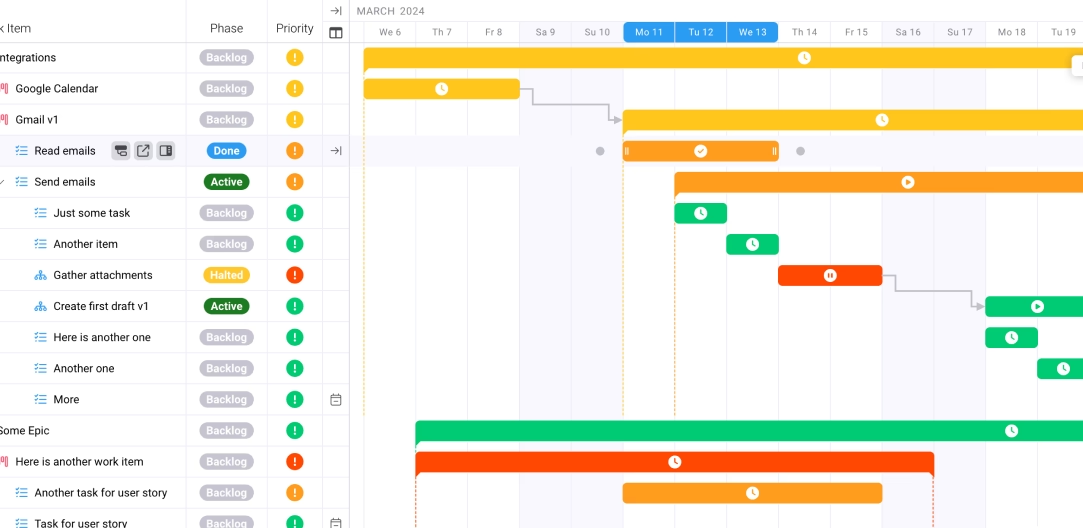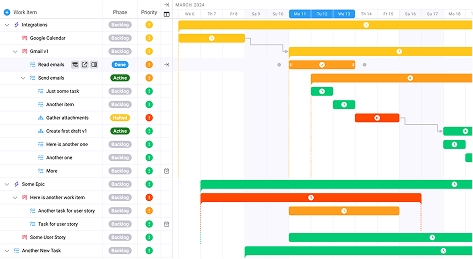
Mastering Client Communication: How to Build Trust and Avoid Scope Creep
Key takeaways:
- Transparent communication: 94% of consumers are likely to be loyal to a brand that offers complete transparency, making transparency the foundation of agency-client relationships
- Scope management crisis: 50% of projects encounter scope creep, while nearly 40% of agencies surpass their project budget because of it
- Communication impact: businesses say that the biggest impact of project management was on team communication (52%)
- Documentation gap: less than 40% of project changes are documented adequately, creating massive risks for agencies
The harsh reality: 55% of Clients are likely to switch from their primary agency in the next 6 months, and the primary culprit isn't poor results—it's failed communication. For marketing agencies, the ability to avoid scope creep while maintaining client trust has become the ultimate differentiator between agencies that thrive and those that barely survive. The most successful agencies understand that mastering client communication isn't just about managing expectations; it's about creating a strategic framework that transforms potential conflicts into opportunities for deeper partnerships.
The Communication Crisis Plaguing Modern Marketing Agencies
Marketing agencies face an unprecedented challenge in 2025. While technical skills and creative capabilities continue to evolve rapidly, the fundamental ability to communicate effectively with clients remains the Achilles' heel of the industry. The statistics are sobering—and they reveal a systemic problem that goes far beyond simple miscommunication.
Consider this: 90% of a project manager's time is spent communicating, yet agencies continue to struggle with scope creep, budget overruns, and client dissatisfaction. The disconnect between communication effort and outcomes suggests that agencies are communicating frequently but not effectively.
The root cause isn't volume—it's clarity, structure, and strategic intent. Most agencies treat client communication as a reactive necessity rather than a proactive strategic advantage. This fundamental misunderstanding costs agencies not just individual projects, but long-term client relationships and ultimately, sustainable growth.
The Trust Foundation
Modern clients don't just want results; they demand transparency throughout the entire process. 83% of consumers worldwide believe transparency is crucial when deciding which brands to support. For marketing agencies, this translates to an even higher standard, as clients are entrusting their brand reputation and marketing investments to external partners.
Research consistently shows that agencies who took part in Marketing Agency Benchmarks Survey said that transparency is the most important factor influencing client retention. Yet many agencies still operate with outdated communication models that prioritize keeping clients "happy" in the moment rather than building genuine trust through honest, transparent dialogue.
The Strategic Framework for Communication Excellence
Successful agencies don't stumble into great client communication—they engineer it. The most effective approach involves creating a systematic framework that addresses both proactive communication and reactive problem-solving. This framework must be built on three foundational pillars: clarity, consistency, and strategic value delivery.
Pillar 1: Clarity Through Documentation
The foundation of effective client communication lies in creating crystal-clear documentation that eliminates ambiguity. This goes far beyond simple project briefs or contracts. Elite agencies develop comprehensive communication protocols that define not just what will be communicated, but how, when, and by whom.
Every touchpoint with the client should serve a strategic purpose. Rather than generic status updates, successful agencies provide insights that help clients understand not just what is happening, but why it matters for their business outcomes. This approach transforms routine communication from a compliance exercise into a value-delivery mechanism.
Pillar 2: Consistency in Message and Method
Inconsistent communication creates confusion and erodes trust faster than almost any other factor. Clients need to know what to expect from every interaction with your agency. This means establishing clear protocols for response times, meeting cadences, reporting formats, and escalation procedures.
The most successful agencies create communication playbooks that ensure every team member interacts with clients in a consistent manner. This consistency extends beyond just messaging to include the methods and tools used for different types of communication. When clients can predict and rely on your communication patterns, trust naturally builds over time.
Pillar 3: Strategic Value in Every Interaction
Every communication touchpoint should reinforce your agency's strategic value to the client's business. This means going beyond task-level updates to provide insights, context, and strategic recommendations. When clients consistently receive valuable insights through your communication channels, they begin to view your agency as an indispensable strategic partner rather than just a service provider.
Implementation Tactics: Five Communication Strategies That Eliminate Scope Creep
Successfully implementing communication excellence requires specific, actionable strategies that address the most common sources of scope creep and client dissatisfaction. The following five tactics have been proven effective across hundreds of agency-client relationships.
Strategy 1: The Boundary-Setting Communication Protocol
The most effective agencies establish clear boundaries from the very first client interaction, but they do so in a way that feels collaborative rather than restrictive. This involves creating what successful agencies call "collaborative boundary setting"—a process where clients actively participate in defining project scope and communication expectations.
Start every client relationship with a comprehensive scope alignment session. This isn't just about getting client approval on deliverables; it's about ensuring genuine understanding of what success looks like from both perspectives. Document not just what you will deliver, but what the client's responsibilities are throughout the process.
Research shows that poor scope management is one of the top reasons large capital projects run over budget and behind schedule, often by 20 to 45 percent according to McKinsey & Company. For marketing agencies, the impact is often even more severe because creative projects tend to be more subjective and open to interpretation than traditional capital projects.
Strategy 2: The Proactive Change Management System
Rather than simply reacting to scope creep when it occurs, leading agencies create systems that anticipate and manage change requests before they become problems. This involves establishing clear processes for evaluating, pricing, and implementing changes while maintaining project momentum.
The key insight here is that scope changes aren't inherently negative. Scope creep can help you build trust and rapport with your client by showing that your team is adaptable, willing to accept feedback, and focused on client success. The difference between destructive scope creep and constructive project evolution lies entirely in how these changes are communicated and managed.
Create a formal change request process that includes impact assessment, timeline implications, and cost adjustments. Present these assessments in a way that helps clients make informed decisions rather than emotional ones. When clients understand the full implications of their requests, they make better decisions that benefit both parties.
Strategy 3: The Transparency-First Reporting Approach
Traditional agency reporting often focuses on metrics that make the agency look good rather than providing genuine insights that help clients make better business decisions. Leading agencies flip this approach entirely, prioritizing client education and strategic insights over positive spin.
Implement what successful agencies call "complete transparency reporting." This means sharing not just what's working, but what's not working, why it's not working, and what you're doing about it. Include context around industry benchmarks, competitive landscape changes, and emerging opportunities that could impact strategy.
This level of transparency often feels counterintuitive—won't clients get upset if they see problems? The opposite is true. Clients become frustrated when they discover problems that were hidden from them. When agencies proactively communicate challenges along with solutions, clients develop deeper trust and confidence in the agency's capabilities.
Strategy 4: The Strategic Communication Calendar
Random, ad-hoc communication creates anxiety and confusion. Successful agencies establish predictable communication rhythms that help clients know what to expect and when. This doesn't mean rigid schedules that can't be adjusted; it means creating reliable frameworks that provide structure while maintaining flexibility.
Develop a strategic communication calendar that includes regular check-ins, progress reviews, strategic planning sessions, and informal relationship-building touchpoints. The key is ensuring that each type of communication serves a specific purpose and provides specific value to the client.
Many agencies make the mistake of thinking more communication is always better. The reality is that strategic, purposeful communication is far more effective than frequent, low-value updates. Clients appreciate agencies that respect their time by making every interaction meaningful.
Strategy 5: The Expectation Alignment System
The most common source of client dissatisfaction isn't poor work quality—it's misaligned expectations. Leading agencies create systematic approaches to continuously align expectations throughout the project lifecycle, not just at the beginning.
Implement regular "expectation check-ins" that go beyond project status updates. These conversations focus on ensuring that both parties still have the same understanding of success criteria, priorities, and constraints. As projects evolve and market conditions change, these alignments become crucial for maintaining positive relationships.
This approach recognizes that client expectations naturally evolve as they learn more about what's possible and as their business needs change. Rather than viewing this evolution as scope creep, successful agencies embrace it as an opportunity to provide even more value.
Measuring Success: The KPIs That Matter for Client Communication
Effective client communication isn't just about feeling good—it's about driving measurable business outcomes for both the agency and the client. The most successful agencies track specific metrics that indicate communication effectiveness and use these insights to continuously improve their approach.
Client Retention and Satisfaction Metrics
The ultimate measure of communication effectiveness is client retention. Agencies with excellent communication practices consistently achieve higher client retention rates and longer average client relationships. Track not just retention rates, but the quality of those relationships through regular satisfaction surveys and Net Promoter Scores.
Leading agencies also monitor what they call "relationship depth metrics"—indicators that show how deeply integrated they are with client operations. This includes factors like the number of client stakeholders they regularly interact with, their involvement in strategic planning sessions, and their access to senior client leadership.
Project Delivery Metrics
Effective communication directly impacts project delivery quality. Track metrics like on-time delivery rates, budget adherence, and change request frequency. Agencies with strong communication practices typically see fewer emergency requests, more predictable project timelines, and higher client satisfaction with final deliverables.
Pay particular attention to the relationship between communication frequency and project outcomes. You may discover that more communication doesn't always lead to better outcomes, but more strategic communication consistently does.
Business Growth Indicators
Strong client communication drives business growth through increased referrals, expanded project scope, and higher project values. Track the percentage of new business that comes from existing client referrals, the average project size growth over time with existing clients, and the frequency of proactive client requests for additional services.
Client retention mastery and relationship building directly correlates with sustainable agency growth. Agencies that excel at client communication often find that their best clients become their strongest advocates and sources of new business growth.
Future Considerations: Evolving Client Communication in 2025 and Beyond
The landscape of client communication continues to evolve rapidly, driven by changing client expectations, new technologies, and shifting market dynamics. Forward-thinking agencies are already adapting their communication strategies to address emerging trends and prepare for future challenges.
Technology Integration and Human Touch
While technology continues to automate many aspects of client communication, the most successful agencies are finding ways to use these tools to enhance rather than replace human connection. AI-powered reporting tools can handle routine updates, freeing up senior team members to focus on strategic conversations and relationship building.
The key is maintaining the human element in all strategic communications while using technology to improve efficiency and consistency in routine interactions. Clients increasingly expect both technological sophistication and personal attention—agencies that can deliver both will have significant competitive advantages.
Evolving Client Expectations
Modern clients are more sophisticated and demanding than ever before. They expect agency partners to understand their business deeply, anticipate their needs, and provide strategic guidance that goes far beyond execution. This evolution requires agencies to develop more consultative communication approaches that position them as strategic advisors rather than just service providers.
The most successful agencies are already adapting their communication strategies to address these evolving expectations. They're investing in team training, developing deeper industry expertise, and creating communication frameworks that demonstrate strategic value at every touchpoint.
Integration with Broader Business Strategy
Effective client communication can no longer be treated as a separate function from business strategy. The agencies that will thrive in the coming years are those that integrate communication excellence into every aspect of their business model, from project management best practices to team training and technology investments.
This integration requires viewing communication not as a support function but as a core competency that drives competitive advantage. Agencies that make this shift often find that their communication capabilities become one of their strongest differentiators in a crowded marketplace.
The future belongs to agencies that can demonstrate measurable business value through every client interaction. By implementing the strategies outlined in this guide and continuously refining their approach based on results, marketing agencies can build the kind of client relationships that drive sustainable growth and competitive advantage.
The journey toward communication excellence isn't always easy, but it's absolutely essential for agencies that want to thrive in an increasingly competitive market. Those who invest in developing these capabilities now will find themselves with significant advantages as client expectations continue to evolve and the competition for top-tier clients intensifies.
Success in client communication requires commitment, consistency, and continuous improvement. The agencies that master these skills will find that their efforts to avoid scope creep and build client trust create a foundation for sustained growth, higher profitability, and more rewarding client relationships.
By focusing on strategic communication frameworks rather than tactical fixes, agencies can create sustainable systems that work regardless of individual clients or team members. This systematic approach to client communication excellence becomes a true competitive differentiator that drives long-term business success.
Remember, the goal isn't just to avoid scope creep—it's to build such strong, trust-based relationships with clients that they become true partners in your agency's growth. When communication becomes a strategic advantage rather than just a necessary function, agencies discover that their client relationships become their greatest business asset. Proven strategies for attracting and retaining high-value clients often start with mastering the fundamentals of client communication and using those skills to build lasting, profitable partnerships.
Frequently Asked Questions
How do I handle clients who constantly request changes outside the original scope?
Establish a formal change request process that includes impact assessment and cost implications. Present changes as opportunities for enhanced value rather than problems, and always provide clear options for how to proceed. Document all changes and their business justification to maintain project integrity.
What's the best way to communicate project delays to clients?
Address delays proactively as soon as they're identified. Provide context about why the delay occurred, what steps you're taking to minimize impact, and how you'll prevent similar issues in the future. Always offer solutions alongside problem identification.
How often should I update clients on project progress?
Establish a regular communication cadence based on project complexity and client preferences. Weekly updates work well for most projects, but high-stakes or complex projects may require more frequent touchpoints. Focus on strategic insights rather than just task completion status.
What should I do when a client questions my agency's expertise or approach?
View these questions as opportunities to demonstrate your strategic value. Provide detailed explanations of your methodology, share relevant case studies or industry benchmarks, and involve the client in understanding the reasoning behind your recommendations.
How can I prevent scope creep without damaging client relationships?
Frame scope boundaries as quality protection rather than limitations. Explain how staying within scope ensures better results, faster delivery, and more focused outcomes. Position yourself as a strategic advisor helping clients make informed decisions about project evolution.
What's the most effective way to build trust with new clients?
Start with complete transparency about your processes, timelines, and potential challenges. Set realistic expectations and consistently deliver on your commitments. Share insights that help clients understand not just what you're doing, but why it benefits their business.
How do I handle communication with multiple stakeholders on the client side?
Establish clear communication hierarchies and decision-making authority at the project outset. Create stakeholder maps that define roles and communication preferences. Use centralized communication tools to ensure all stakeholders have access to the same information.
What should I include in project status reports to maximize value?
Focus on business impact rather than just task completion. Include strategic insights, market context, performance against benchmarks, and recommendations for optimization. Always connect tactical activities to business outcomes the client cares about.
How can I turn scope creep into additional revenue opportunities?
Position scope changes as strategic enhancements that provide additional value. Present clear options with associated costs and benefits. Help clients understand how changes align with their broader business objectives and provide ROI justification for expanded scope.
What's the best way to document client communications to protect my agency?
Maintain detailed records of all client interactions, decisions, and approvals. Use email summaries after verbal conversations to confirm understanding. Document not just what was agreed upon, but the reasoning behind decisions to provide context for future reference.









